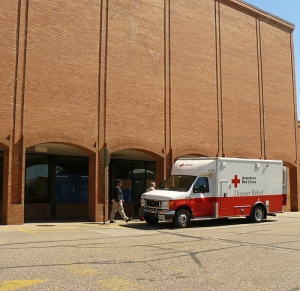
Beth Kanter
This is a guest post from The A-List podcast guest Beth Kanter. Beth is the author of Beth’s Blog: How Nonprofits Can Use Social Media, one of the longest running and most popular blogs for nonprofits. She is a frequent technology trainer and speaker and in 2009, she was named by Fast Company magazine as one of the most influential women in technology and one of Business Week’s “Voices of Innovation for Social Media.” She is the 2009 Scholar in Residence for Social Media and Nonprofits for the Packard Foundation. A frequent contributor to many nonprofit technology web sites,blogs, and magazines, Beth has authored chapters in several books, including the ROI chapter in “Managing Technology to Meet Your Mission: A Strategic Guide for Nonprofit Leaders,” edited by NTEN published in 2009. She is currently co-writing a book with Allison Fine to be published by Wiley in 2010 called “The Networked Nonprofit.” You can read Beth’s complete biography here.
The American Red Cross initiated its social media strategy shortly after Hurricane Katrina in 2006. The organization knew there were negative blog posts about its disaster relief efforts, but had no capacity to respond, let alone track. They hired Wendy Harman, a social media integrator, to “combat” bloggers and to increase organizational transparency. “It felt like we were going to war. There were concerns about negative comments, fear even,” says Wendy whose current title is Social Media Manager.
Her first task was to identify and follow the existing conversations. “There were hundreds of mentions across social media platforms each day. I had to set up a listening post to monitor and analyze them as well as figure out how or if to respond.”
The American Red Cross started a listening program with some key goals: correct misinformation, to be informed about public opinion, to track conversation trends, to identify influencers, and to build relationships. Wendy Harman notes, “We needed to listen and engage first before we could do anything successfully with social media.”
Listening to bloggers initially, and later on Twitter and other sources, has helped informed communications strategies. Says Harman, “People were blogging about their blood donation experience and sharing intimate details of the experience – like the type of cookie they got afterwards. These conversations inform advertising and outreach to increase blood donations, which of course is one metric for success.”
What surprised the staff at the American Red Cross and even Wendy herself, was the majority of these conversations were positive. Notes Harman, “We found that most are passionate and positive and want to help. Social media offers us a way to engage them and tell their stories about their experience with us to others.”
Perhaps the biggest benefit that the Red Cross reaped from its listening efforts is that drove internal adoption of social media. Wendy says people are no longer afraid of negative comments or posts. “The opposite of hate is indifference, if someone bothers to post a negative comment it means they care.” Negative comments are now viewed by the organization as an opportunity to educate and improve what they are doing.
What started in 2007 as a series of listening and engaging experiments has now begun to pay off. In December 2008, thousands of Facebook members helped leveraged a $50,000 donation from the Western Union Foundation by voting for the American Red Cross and its disaster relief efforts on Facebook. The $50,000 donation contributed to a broader American Red Cross goal to raise $100 million for disaster relief.
Wendy Harman noted that employees at the Red Cross were initially blocked from accessing social networking sites, like Facebook, from work. Recently, a change in policy has allowed access, in part, due to the listening work undertaken with Harman’s leadership.
Harman spends approximately 10 hours per week listening. “In the beginning it took a little bit longer because I had a learning curve.” Harman compiles daily mentions on blogs into a one-page update that is distributed to staff and affiliates. She notes, “It isn’t rocket science, just keyword searches across social media platforms.”
As the professional listener on the Red Cross staff, her main challenge is dealing with the tsunami of information to analyze and she has now incorporated Radian 6 into her toolbox. “The professional tools get rid of a lot of cut and pasting, so that has helped. Also, we’re looking at ways to represent the information visually. For example, I’ve bookmarked posts about people talking about the Red Cross and ran it through wordle.com, a tool that creates a visual tag cloud.”
The American Red Cross has also established a response policy for commenting on blogs or replying on Twitter. Says Harman, “I organize the report by subject matter and if I need help answering I consult with others on staff. This approach generally keeps everyone abreast of what people are saying about the Red Cross in the social space.”
Wendy uses the authority ranking from Technorati to help guide whether or not they should comment on a blog. As Wendy notes, “Authority matters but is not everything. Sometimes most compelling story or most pressing issue comes from social media user with little influence.”
Harman says that responses fall into several categories. These include: relationship building (someone is saying something nice about us and we say thank you) or there is a customer service issue or perception that needs to addressed. Harman also reviews reports over time to look at different. These insights not only fuels their social media strategy, but also inform program design, fundraising, communications, and virtually the entire organization.
Wendy says that it is really important to document anecdotal evidence when making the case for the ROI of Social Media, especially feedback from staff members about how the listening process supports their work. She also documents how external stakeholders have engaged with the Red Cross literally sharing screen captures of the actual tweet or blog comment. This drives adoption.
Over time, the organization has come to appreciate and value the listening reports. And, the Red Cross community now knows that the organization is listening and the conversation has changed, relationships deepened. Most recently, engagement has also led to dollars. In May 2009, the Red Cross was one of ten organizations selected by Target to participate in a Facebook competition where supporters voted for a share of the corporate philanthropy budget of $3 million. The Red Cross was able to leverage a donation of $750,000.
As Wendy Harman sums it up, “Social media listening has become the gateway drug of the organization.”
Has listening become a gateway drug in your nonprofit organization? If so, how?
This is the final post of Beth Kanter’s series on Listening Literacy For Nonprofits. I thank her from the bottom of my heart for this inspiring and useful information.


